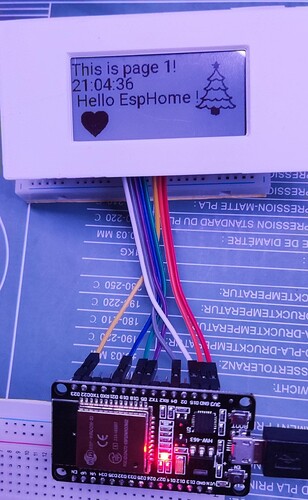Hello,
I’m using the waveshare library with a 2.13" e-ink screen (GDEY0213Z98 122x250 tri-color). I know the tri-color not working yet, but it’s ok without.
My esp is a esp32doit-devkit-v1, here is it’s pinout:
So far, by using model 2.13in and it nearly works.
The main issue I have is that the library seems to not be able to initalize properly the screen, sometime (after a re-plug) or by testing some parameters (at the begining) the screen was either completely messed up, or esphome was unable to send new data.
In this state, even by trying lot of parameters, the screen doesn’t change anymore whatever I try.
The only way to get out this situation is to re-flash with an Arduino with GxEPD2 library (which supports my screen), and without touching any wires (same pin configuration on esphome and arduino) the screen became alive again.
Then I can reflash with esphome and it “works” like before.
If I could find a way to proper reset the screen, it would “solve” my major issue.
The second issue is the colors are inverted : i need to draw a black rectangle, then print on draw in white, the screen flicker a few times, then finish inverted. The pictures need to be inverted to, like mdi icons.
This is managable.
here is my esphome code for reference:
esphome:
name: test-display
friendly_name: test-display
# on_boot:
# priority: 700
# then:
# - delay: 2sec
# - component.update: my_display
# - delay: 100ms
# - component.update: my_display
# - delay: 100ms
# - component.update: my_display
# - delay: 100ms
# - component.update: my_display
# - delay: 100ms
esp32:
#board: esp32dev
board: esp32doit-devkit-v1
framework:
type: arduino
# Enable logging
logger:
# Enable Home Assistant API
api:
encryption:
key: "XXXXXXXXXXXXXXXXXXXXXXXXXXXXXXXXX="
ota:
password: "XXXXXXXXXXXXXXXXXXXXX"
wifi:
ssid: !secret wifi_ssid
password: !secret wifi_password
# Enable fallback hotspot (captive portal) in case wifi connection fails
ap:
ssid: "Test-Display Fallback Hotspot"
password: "ePniM3Ko8fCm"
captive_portal:
# external_components:
# - source:
# type: git
# url: https://github.com/esphome/esphome
# ref: beta
# components: [ waveshare_epaper ]
time:
- platform: sntp
id: esptime
font:
- file: "gfonts://Roboto"
id: font1
size: 24
glyphs: "!\"%()+=,-_.:°0123456789ABCDEFGHIJKLMNOPQRSTUVWXYZ abcdefghijklmnopqrstuvwxyzéèêàïùÉÈÊÀÏÙ"
spi:
clk_pin: GPIO18
mosi_pin: GPIO23
miso_pin: GPIO19 #not connected for using external SPI
text_sensor:
- platform: homeassistant
id: display_text
entity_id: input_text.calendrier_text
on_value:
- component.update: my_display
image:
- file: "sapin.png"
id: sapin
resize: 80X80
- file: mdi:heart
id: heart
resize: 48x48
qr_code:
- id: wled_link
value: "https://play.google.com/store/apps/details?id=com.aircoookie.WLED"
display:
- platform: waveshare_epaper
#id: my_text
cs_pin: GPIO21 #GPIO2
dc_pin: GPIO5
busy_pin: GPIO15 #GPIO19
reset_pin: GPIO4
id: my_display
model: 2.13in #pos ok, blikns + fade
#model: 2.13in-ttgo # pos ok, color inverted, clignotte
#model: 2.13in-ttgo-b73 #pos ok, clignotte, fond gris
#model: 2.13in-ttgo-b74 #pos ok blinks
#model: 2.13in-ttgo-b1 #KO
#model: 2.13in-ttgo-dke # lot of noise, with waveshare beta
#model: 2.90inV2 #pos KO , clignotte
rotation: 270°
full_update_every: 1
update_interval: 60s
#reset_duration: 10ms # also tryed 2ms, 10ms, 100ms ...
#update_interval: 2
#full_update_every: 1
pages:
- id: page1
lambda: |-
it.filled_rectangle(0,0,250,122, COLOR_ON);
it.print(2, 2, id(font1), COLOR_OFF, "This is page 1!");
it.strftime(2, 24, id(font1), COLOR_OFF, "%H:%M:%S", id(esptime).now());
//it.print(2, 46, id(font1), COLOR_OFF, id(display_text).state)
it.image(170, 10, id(sapin));
it.printf(2, 46, id(font1), COLOR_OFF," %s ", id(display_text).state.c_str());
it.image(10, 70, id(heart), COLOR_OFF);
- id: page2
lambda: |-
it.filled_rectangle(0,0,250,122, COLOR_ON);
it.qr_code(30, 5, id(wled_link), COLOR_OFF, 3);
- id: page3
lambda: |-
it.filled_rectangle(0,0,250,122, COLOR_ON);
# lambda: |-
# it.filled_rectangle(0,0,250,122, COLOR_ON);
# it.printf(0, 0, id(font1), "Hello new !", COLOR_OFF);
# // Draw the same rectangle, but this time filled.
# //it.filled_rectangle(50, 60, 30, 30);
# //it.filled_rectangle(70, 80, 30, 30, COLOR_OFF);
#not working
# interval:
# - interval: 30s
# then:
# - display.page.show_next: my_display
# - component.update: my_display
button:
- platform: template
name: "Template Button"
on_press:
- logger.log: Button Pressed
- display.page.show_next: my_display
- component.update: my_display
I didn’t remove a lot comments to let you know what I already tested
Some help would be appreciated ![]()
Kytrix

